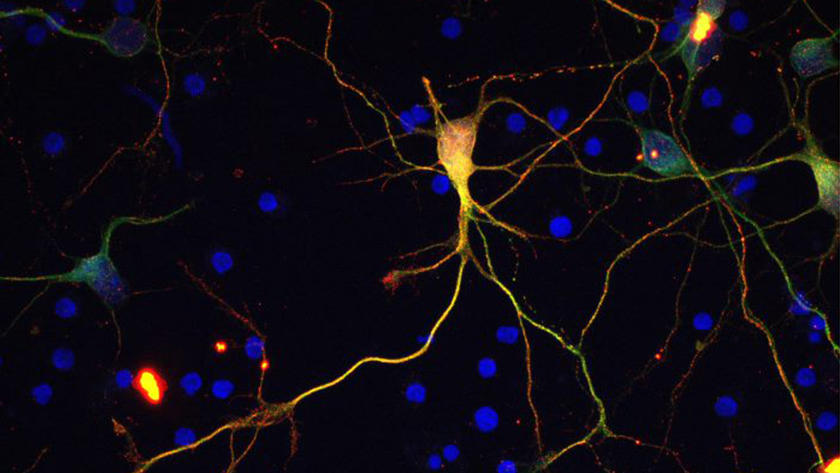
In a study published in Nature Communications, a team led by Krembil Brain Institute Senior Scientists Drs. Lorraine Kalia and Suneil Kalia and University of Toronto (UofT) Professor Dr. Philip M. Kim identified a protein-protein interaction that contributes to Parkinson disease.
In the disease, a protein called α-synuclein (a-syn) accumulates in the brain and leads to cell death. Much research is currently focused on clearing a-syn with antibodies or using small molecules to prevent a-syn from aggregating. In this study, the researchers took an alternate approach by looking for protein-protein interactions that may be promoting the accumulation of a-syn.
Protein-protein interactions govern virtually all the inner workings of cells, including breaking down disease-causing proteins. Inhibiting certain interactions has emerged as a promising approach to treat diseases, such as stroke and cancer.
“We were interested in applying the approach of disrupting protein-protein interactions to Parkinson disease. However, identifying a particular interaction that contributes to a disease and then finding ways to disrupt it can be a painstaking and incredibly slow process,” explains Dr. Lorraine Kalia, who is also a Staff Neurologist at UHN and a Scientist at UofT’s Tanz Centre for Research in Neurodegenerative Diseases in the Temerty Faculty of Medicine.
According to Dr. Kim, the team took the reverse approach to expedite the discovery of potential therapies. “We developed a platform to screen molecules called peptide motifs—short strings of amino acids that can disrupt protein-protein interactions—for their ability to protect cells from a-syn. Once we identified candidate peptides, we determined which protein-protein interactions they target.”

Dr. Philip Kim is a Professor and Principal Investigator at the Donnelly Centre for Cellular and Biomolecular Research and the departments of Molecular Genetics and Computer Science at the University of Toronto. Dr. Kim’s lab applies computational and high-throughput methods to identify and design therapeutic compounds.
Through this approach, the team identified a peptide that reduced a-syn levels in cells by disrupting the interaction between a-syn and a protein subunit of the cellular machinery called ‘endosomal sorting complex required for transport III’ (ESCRT-III).
“ESCRT-III is a component of a pathway that cells use to break down proteins, called the endolysosomal pathway,” explains Dr. Lorraine Kalia. “We discovered that a-syn interacts with a protein within ESCRT-III—called CHMP2B—to inhibit this pathway, thereby preventing its own destruction.”
According to Dr. Suneil Kalia, once the group identified this interaction, they confirmed that they could use their peptide to disrupt it, preventing a-syn from evading the cell’s natural clearance pathways.
“We tested the peptide in multiple experimental models of Parkinson disease, and we consistently found that it restored endolysosomal function, promoted a-syn clearance and prevented cell death.”
These findings indicate that the a-syn-CHMP2B interaction is a potential therapeutic target for the disease, as well as other conditions that involve a buildup of a-syn.
The next steps for this research are to clarify exactly how a-syn and CHMP2B interact to disrupt endolysosomal activity. Ongoing studies are also determining the best approach for delivering potential therapeutics to the brain.
“This research is still in its early stages—more work is definitely needed to translate this peptide into a viable therapeutic,” cautions Dr. Lorraine Kalia. “Nonetheless, our findings are very exciting because they suggest a new avenue for developing treatments for Parkinson disease and other neurodegenerative conditions.”
This study also highlights the value of multidisciplinary collaborations in health research.
“We simply could not have conducted this study in a silo,” says Dr. Suneil Kalia. “The endolysosomal pathway is underexplored, so it was not an obvious place to look for potential disease-related protein-protein interactions. Dr. Kim’s screening platform was critical for pointing us in the right direction.”
Dr. Kim says, “It is extraordinary to see this platform—which we initially used to find potential therapeutics for cancer—yielding advances in brain research. The pathways that cells use to stay healthy are fundamentally very similar across tissues, so the insights that we gain about one organ system or disease could have important implications in other contexts.”
This work was supported by the Canadian Institutes of Health Research, the Michael J. Fox Foundation for Parkinson’s Research, Parkinson’s UK, the Canada Foundation for Innovation, the Ontario Research Fund, the Krembil Research Institute and the UHN Foundation. Dr. Lorraine Kalia is an Associate Professor in the Division of Neurology, Department of Medicine, and in the Department of Laboratory Medicine and Pathobiology at UofT. Dr. Suneil Kalia is an Associate Professor in the Division of Neurosurgery, Department of Surgery, and in the Department of Laboratory Medicine and Pathobiology at UofT, and is the R.R. Tasker Chair in Stereotactic and Functional Neurosurgery at UHN. Dr. Philip M. Kim is a Professor and Principal Investigator at the Donnelly Centre for Cellular and Biomolecular Research, the Department of Molecular Genetics and the Department of Computer Science at UofT.
UofT submitted a patent application covering the composition and use of the peptides and screening methods outlined in this study, with Drs. Satra Nim, Carles Corbi-Verge, Suneil Kalia, Lorraine Kalia and Philip Kim as inventors. Drs. Suneil Kalia, Lorraine Kalia and Philip Kim co-founded Synepark Therapeutics Inc. to commercialize aspects of this research.
Nim S, O’Hara DM, Corbi-Verge C, Perez-Riba A, Fujisawa K, Kapadia M, Chau H, Albanese F, Pawar G, De Snoo ML, Ngana SG, Kim J, El-Agnaf OMA, Rennella E, Kay LE, Kalia SK, Kalia LV, Kim PM. Disrupting the α-synuclein-ESCRT interaction with a peptide inhibitor mitigates neurodegeneration in preclinical models of Parkinson’s disease. Nat Commun. 2023 April 19. doi: 10.1038/s41467-023-37464-2.

Image of a cultured neuron expressing the protein a-syn. Photo credit: Kashfia Shafiq, Kalia Labs, UHN.




